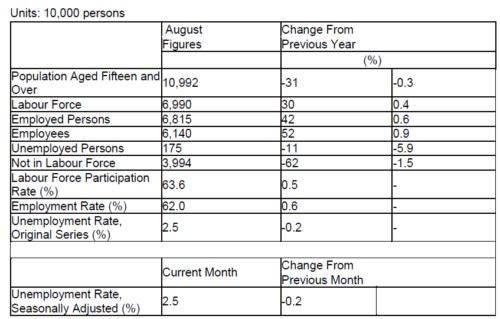Economic and Labour Situation in Japan, October 2024
FY 2024 Prefectural Minimum Hourly Wages Rise to National Average of 1055 Yen
Prefectural minimum hourly wages for fiscal 2024 have risen to a national average of 1,055 yen per hour, up 51 yen over the previous fiscal year. Regional Minimum Wage Councils (tripartite bodies comprising public interest, labour, and management representatives) had been discussing prefectural levels following an announcement of guidelines earlier in the year by the government’s Central Minimum Wage Council. All of Japan’s 47 prefectures have now determined their fiscal 2024 minimum wages, which went into force from October 1.
None of the 47 failed to implement the recommended margin of 51 yen to 84 yen amid soaring prices for daily necessities and many other items. Minimum hourly wage rises exceeded central government proposals in 27 prefectures.
At present, Tokyo has the highest minimum hourly wage at 1163 yen, up 50 yen. Akita has the lowest at 951 yen, up 54 yen, which is more than 212 yen below Tokyo’s.
Recently appointed Prime Minister Ishiba has emphasized it is vital for Japan to promote robust wage growth as private consumption currently lacks vigor, and he wants Japan to have a 1,500 yen minimum wage before the decade is out, greatly accelerating current plans.
Labour Force Survey Monthly Results*1
More people find better work in August
(1) Employment
The number of employed persons in August 2024 was 68.15 million, an increase of 420,000 over the same month the previous year. By gender, this included 37.12 million men, up 50,000, and 31.04 million women, up 380,000 over the previous year.
(2) Unemployment
The number of unemployed persons in August 2024 was 1.75 million, a decrease of 110,000 from the same month in the previous year.
The seasonally adjusted unemployment rate in August was 2.5%, down 0.2 points from the previous month, following a deterioration in July, as more workers who had been seeking better conditions found new jobs. The unemployment rate for men was 2.5%, down 0.2 points from the previous month, and for women 2.4%, down 0.2 points from the previous month.

(3) Job Availability
Japan’s job availability in August stood at 1.23, down 0.01 points over the previous month. This ratio means there were 123 job openings for every 100 job seekers.
The ratio of regular employee job offers to applicants was 1.01, up 0.01 over the previous month.
The ratio of new job offers to applicants, a leading indicator for the labour market, was 2.32, up 0.10 points over the previous month. The number of new job offers decreased 6.5%. By industry, information and communications increased 1.4%. The accommodation and food services sector and manufacturing dropped 23.5% and 10.5% respectively.
Industrial Production*2
Industrial output in August decreased 3.3% from the previous month, partly due to a powerful typhoon that affected car production.
Production, shipment, and inventories all decreased, while inventory ratio increased. The industries that mainly contributed to this decrease were as follows: (1) motor vehicles; (2) electrical machinery and information and communication electronics equipment; and (3) production machinery, in that order.
According to the Survey of Production Forecasts in Manufacturing, production was expected to increase 2.0% in September and decrease 6.1% in October.

Family Income and Expenditure Survey *3
(1) Expenditure of Households of Two Persons or More
Average monthly consumption expenditure of households of two or more persons in August was 297,487 yen, up 1.5% in nominal terms but down 1.9% in real terms from the previous year. This marks the first decrease in two months. Spending on car purchases and travel decreased due to the impact of typhoons and the Nankai Trough Earthquake Emergency Information (Major Earthquake Warning) issued in early August.
(2) Income and Expenditures for Workers’ Households
Average monthly income per household stood at 574,334 yen, up 5.6% in nominal terms and up 2.0% in real terms over the previous year. The average level of consumption expenditure was 318,764 yen per month, up 2.3% in nominal terms but down 1.2% in real terms year-on-year.
Consumer Prices *4
The consumer price index (CPI) in August was 109.1 (2020 = 100), up 3.0% over the previous year and up 0.5% over the previous month. Core inflation (CPI less food and energy) was up 2.0% over the previous year and up 0.5% over the previous month, reflecting higher energy costs and higher rice prices.
Prices for rice, Japan’s staple food, soared 28.3%, the highest increase in nearly 49 years, due to short supply following last year’s hot summer and higher demand from restaurants. Electricity costs and city gas prices climbed 26.2% and 15.1% respectively. The government decided to resume subsidies temporarily from September.

<Y.A>
- Source: Labour Force Survey Monthly Results (Statistics Bureau of Japan)
https://www.stat.go.jp/english/data/roudou/results/month/index.html - Source: Indices of Industrial Production (Ministry of Economy, Trade and Industry)
https://www.meti.go.jp/english/statistics/tyo/iip/index.html - Source: Summary of the Latest Month on Family Income and Expenditure Survey (Statistics Bureau of Japan)
https://www.stat.go.jp/english/data/kakei/156.html - Source: Consumer Price Index (Statistics Bureau of Japan)
https://www.stat.go.jp/english/data/cpi/1581-z.html
